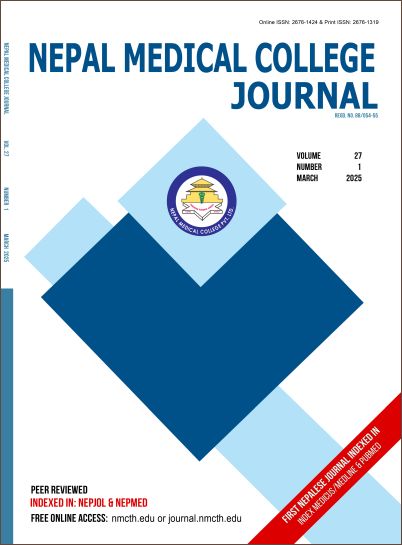Variation in the Branching Pattern of the Dorsalis Pedis Artery: A Cadaveric Study
DOI:
https://doi.org/10.3126/nmcj.v27i1.77539Keywords:
Anatomy, arcuate artery, dorsalis pedis artery, variationsAbstract
Dorsalis pedis artery is the main artery of foot. It has been shown to have a variation in its origin, course and branching pattern. The present study aimed to assess the variation in artery and the different branching patterns of the dorsalis pedis artery that exist in a Nepali population. The study was carried out in 52 dissected limbs of 23 males and 3 females all together, in Department of Human Anatomy, Nepal Medical College Teaching Hospital, Attarkhel, Gokarneshwor-8, Kathmandu, Nepal. The dissections were carried out on embalmed cadavers placed in supine position on a dissecting table with the neck in neutral position. After dissection, the status of the artery and the branching pattern was observed and recorded in the predesigned table. All the recorded measurements were analyzed by using descriptive statistics in SPSS-16. The normal pattern was observed on 41 (78.84%) limbs while rest of the limbs showed variations. A missing arcuate artery pattern was observed in six, limbs while an extra lateral tarsal artery was found in three limbs. The mean diameter of the artery with normal branching pattern was 4.24 ± 0.90 mm. and the mean diameter of the artery with variation in branching pattern was 3.80 ± 0.40 mm. In conclusion, this study revealed variations in dorsalis pedis artery. These findings are considered informative and helpful for the orthopedics surgeons and podiatrists performing foot reconstructive procedures.
Downloads
Downloads
Published
How to Cite
Issue
Section
License
Copyright (c) 2025 Nepal Medical College Journal

This work is licensed under a Creative Commons Attribution 4.0 International License.
This license enables reusers to distribute, remix, adapt, and build upon the material in any medium or format, so long as attribution is given to the creator. The license allows for commercial use.




